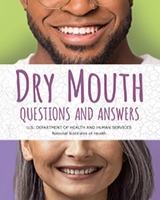Sjögren's Disease
Overview
Sjögren's (SHOW-grins) disease is an autoimmune disorder that reduces the amount of tears in the eyes and saliva in the mouth. As a result, people with Sjögren's disease have dry mouth and dry eyes. Dry mouth affects taste, makes chewing and swallowing more difficult, and increases the risk for cavities, tooth loss, and infections in the mouth.
In addition, Sjögren's disease may cause skin, nose, and vaginal dryness, and may affect other parts of the body including the kidneys, blood vessels, lungs, liver, pancreas, and brain.
Sjögren's disease affects 1 - 4 million people in the United States and occurs in all races and ethnicities. Most people are more than 50 years old when they are first diagnosed. Women are nine times more likely to have Sjögren's disease than men.
Back to topCauses
Sjögren's disease is an autoimmune disorder in which immune cells mistakenly attack and destroy healthy cells in the glands that produce tears and saliva. Scientists think Sjögren's disease is caused by a combination of genetic and environmental factors. Several genes appear to be involved in the development of Sjögren's disease. Some scientists think that Sjögren's disease may happen because of a previous infection with a virus or bacteria.
Back to topSymptoms
The main symptoms of Sjögren's disease are:
- Dry mouth. Your tongue and your throat will feel dry and chewing and swallowing may be difficult or painful.
- Dry eyes. Your eyes may burn or itch or feel as if you have a piece of sand in your eye. Vision may be blurry, or you could be bothered by bright light.
Sjögren's disease can also affect other parts of the body, causing symptoms such as:
- Joint and muscle pain.
- Dry skin.
- Rashes on the skin of hands or feet.
- Numbness or tingling in the hands or feet.
- Vaginal dryness.
- Dry cough that doesn't go away.
- Fatigue that doesn't go away.
If you have Sjögren's disease you may only have mild symptoms of dry eyes and mouth, or you could experience cycles of mild symptoms followed by more severe symptoms.
Back to topDiagnosis
A doctor diagnoses Sjögren's disease using your medical history, a physical exam, and the results from clinical or laboratory tests. During the physical exam, a doctor checks for the physical signs of Sjögren's disease such as a dry mouth, or signs of other diseases related to Sjögren's disease such as lupus or rheumatoid arthritis.
Depending on what the doctor finds during the medical history and physical exam, he or she may do more tests or refer you to a specialist.
Back to topTreatment
There is still no cure for Sjögren's disease. Treatment can vary from person to person, depending on which parts of the body are affected. Moisture replacement therapies such as eye drops, and ointments may relieve dryness in the eyes. There are saliva substitutes and prescription drugs to help increase saliva production. Simply drinking small sips of water regularly throughout the day may also help. If you have joint pain, nonsteroidal anti-inflammatory drugs may offer some relief. If symptoms are severe, corticosteroids or immunosuppressive drugs may be prescribed.
Back to topHelpful Tips
Tips for Dry Mouth
Saliva helps clean your teeth and reduce the amount of bacteria in your mouth that causes dental decay. This means that good oral hygiene is important if you have dry mouth. Here's what you can do to prevent cavities and infections:
- Visit a dentist at least twice a year to have your teeth examined and cleaned.
- Keep a glass of water nearby - day and night - and drink small sips regularly to keep your mouth moist.
- Use lip balm if your lips are dry and cracked.
- Use toothpaste that contains fluoride and gently brush your teeth, gums, and tongue after each meal and before bedtime.
- Floss your teeth regularly.
- Avoid sugary foods and sugary drinks. If you do eat or drink sugary foods, brush your teeth right after. Choose sugar-free gum, candy, and soda.
- Ask your dentist whether you need to use a fluoride mouthrinse, use a fluoride gel at night, or have fluoride varnish put on your teeth to protect them from decay.
Tips for Dry Eyes
- Use eye drops that don't irritate your eyes. Talk with your doctor to find the best drops for you.
- Practice blinking. When reading or using the computer try to remember to blink five to six times a minute.
- Protect your eyes from drafts, breezes, and wind, which can be drying.
- Use humidifiers in the rooms where you spend the most time or install a humidifier in your heating and air conditioning unit.
- Don't smoke, and stay out of smoky rooms.
Additional Resources
- NIH MedlinePlus Magazine – Summer 2020
TV personality Carrie Ann Inaba talks about her experience with Sjögren's; NIDCR shares the latest research on this condition and answers questions about dry mouth, a common symptom. - NINDS Sjögren's Information Page
Information from the NIH National Institute of Neurological Disorders and Stroke on treatment and prognosis for people with Sjögren's Syndrome and current research on the disease. - NIAMS Sjögren’s Information Page
Information from the NIH National Institute of Arthritis and Musculoskeletal and Skin Diseases, including Sjögren’s symptoms, diagnosis, the types of doctors to see, treatment, and ongoing research. - NLM Medline Plus: Sjögren's
The NIH National Library of Medicine's collection of links to government, professional and non-profit/voluntary organizations with information on Sjögren's. - Sjögren's Foundation
The Sjögren's Foundation is a national non-profit organization focused on increasing research, education, and awareness for Sjögren's.
Related Publications
Back to topSjögren's Disease Research from NIDCR
October 2024

